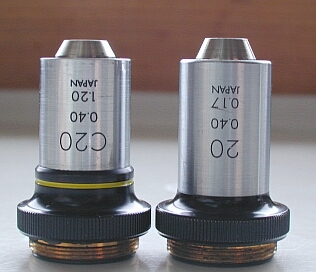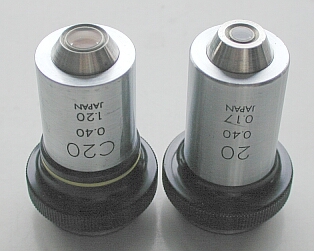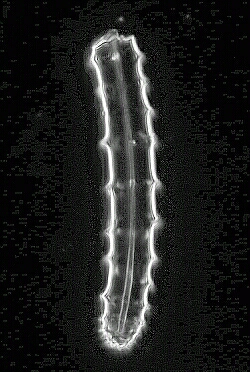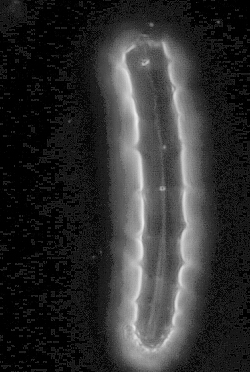 |
LWD has shorter barrel length of about 2mm. Olympus achromat objectives x20 0.4na. Front element 'hollow' ground for LWD and is larger to maintain na. |
 |
| The Long Working Distance
Objective
A useful aid for pond water investigations By Paul James (UK) |
It occurred to me
that the LWD Objective, which was primarily designed for use in
inverted microscopes, where the need to peer through thicker
glass bottomed receptacles was required, might be rather useful
for use in standard microscopes whilst observing pond water
specimens. The logic behind this was simple: coverslipped
pondwater samples can often have a range of material in situ
which raises the coverslip beyond the working distance of the
objective. Even if the standard objective can be focussed, its
0.17mm coverslip correction cannot cope properly in this
situation and so spherical aberrations will ensue. This flaw is at
its worst when observing delicate organisms in darkfield,
revealing flare in the image. (See below.)
 |
LWD has shorter barrel length of about 2mm. Olympus achromat objectives x20 0.4na. Front element 'hollow' ground for LWD and is larger to maintain na. |
 |
With 'deep' water mounting under coverslip OR use of deep celled slides the performance of the LWD Objective in darkfield is noticeably superior to that of the standard objective. The images below reveal the benefits of using the LWD objective in darkfield. Brightfield yields more faithful imagery too, though the difference is less exagerated but nevertheless obvious in A-B comparisons. The subject is a siliceous fragment from a radiolarian? resting at the bottom of a depressed cell slide. (The image is a crop from the image's centre and therefore seems exaggerated in scale and degree of spherical aberration, but still is very noticeable in live observations.)
 |
 |
STANDARD OBJ (Sph. aberration) |
Depressed cell slides
Also, those observers who enjoy medium power views of pondlife on slides with depressed cells will gain dividends by using such an objective. In the case of this particular optic from Olympus its 'coverslip' correction is for glass of 1.2 mm thickness and therefore will yield excellent imagery from one of these cells with ease, both as regards working distance and optical corrections. Rotifers for instance, can 'enjoy' a more natural disposition inside a deep cell, and whilst the true water objective has the edge when observing these specimens, the cost of a suitable x20 optic might exceed the value of a dozen used Olympus LWD C20's??
Final thoughts
One of the secrets in the quest of rewarding microscopy is to trying to solve problems and there is usually a way round them. The LWD objective, especially in the x20 - x40 range is one answer to one problem for some pondwater practitioners, and more especially DF enthusiasts.
Though the difference in working distance might only be 1.5-2mm over the standard objective, it is a large measure in microscopy..............'Elbow room' with corrections too!
| All comments welcome by the author Paul James |
Microscopy
UK Front Page
Micscape
Magazine
Article
Library
Please report any Web problems or offer general comments to the Micscape Editor.
Micscape is the on-line monthly magazine of the Microscopy
UK web
site at Microscopy-UK